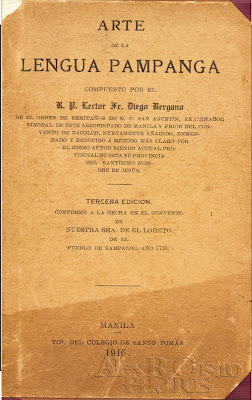 ARTE DE LA LENGUA PAMPANGA. The 3rd edition of Fr. Diego Bergano's breakthrough work on Kapampangan grammar, published by the University of Sto. Tomas in 1916.
ARTE DE LA LENGUA PAMPANGA. The 3rd edition of Fr. Diego Bergano's breakthrough work on Kapampangan grammar, published by the University of Sto. Tomas in 1916.In 1594, the Archbishop of Manila issued a royal decree allowing missionaries to focus their linguistic efforts on 3 or 4 languages to be able to work efficiently with the natives. At that time, the Augustinians were doing mission work among Tagalogs, Ilocanos, Hiligaynons, Cebuanos—and the Kapampangans. Many religious became very proficient with their languages and those who mastered the languages started to write books as guides for others: Arte (Grammar), Vocabulario (Dictionary) and the Doctrina (Catechism).
There is strong evidence to suggest that the 1st Augustinian printing press was set up in Lubao, Pampanga as noted by chronicler Fr. Gaspar de San Agustin, author of “Conquistas de las Islas Filipinas”, who wrote…”for a long time, there was in it (Lubao) a school of grammar and rhetoric, and there was too, a good printing press bought from Japan”. This press was moved according to the needs of the religious, printing everything from novenas, lives of saints to grammar books.
In Macabebe, Fr. Francisco Coronel authored “Artes y Reglas de la Lengua Pampanga” (1617) which was based on the 3-volume grammar-vocabulary book by Fr. Diego de Ochoa. Later, Fr. Alvaro de Benavente completed “Arte y Vocabulario de la lengua Pampanga”, which remained in manuscript form.
The first real Pampango grammar book would come out of the press over a century later, by the erudite priest Fr. Diego Bergano. Born in 1690 in Palencia, Spain, Fr. Bergano was ordained at the monastery of Badaya in 1710. Eight years later, he secured his first Philippine assignment. After arduously studying the Kapampangan language for 3 years in San Agustin, Intramuros. He was appointed parish priest of Mexico town (1725) and Bacolor (1737-1747). He rose to become an examinador sinodal and prior of San Agustin in 1731 and became prior provincial-elect in 1734.
Fr. Bergano’s best known work is the breakthrough “Arte de la Lengua Pampanga”, which came out of the Jesuit press in 1729. This book was so well-written and received so much attention that a 2nd edition was published in 1736 from the Franciscan press in Sampaloc. The 3rd edition was published by the University of Sto. Tomas in 1916. The pioneering volume covered the rules of Kapampangan grammar, ranging from proper declensions, voices and moods, conjugations and word usages.
The dedicated priest also authored “Vocabulario de Pampango en Romance y Diccionario de Romance en Pampango” (Pampango-Spanish/Spanish-Pampango Dictionary), with the help of Juan de Zuniga, a member of Mexico’s principalia class. Fr. Bergano easily mastered the complexities of Kapampangan, right down to the precise syntax. His works on the language were considered to be the finest, prompting Fr. Casimiro Diaz to comment “..the work came out so perfect, that there is nothing more to say or criticize..”.
(*NOTE: Feature titles with asterisks represent other writings of the author that appeared in other publications and are not included in the original book, "Views from the Pampang & Other Scenes")
There is strong evidence to suggest that the 1st Augustinian printing press was set up in Lubao, Pampanga as noted by chronicler Fr. Gaspar de San Agustin, author of “Conquistas de las Islas Filipinas”, who wrote…”for a long time, there was in it (Lubao) a school of grammar and rhetoric, and there was too, a good printing press bought from Japan”. This press was moved according to the needs of the religious, printing everything from novenas, lives of saints to grammar books.
In Macabebe, Fr. Francisco Coronel authored “Artes y Reglas de la Lengua Pampanga” (1617) which was based on the 3-volume grammar-vocabulary book by Fr. Diego de Ochoa. Later, Fr. Alvaro de Benavente completed “Arte y Vocabulario de la lengua Pampanga”, which remained in manuscript form.
The first real Pampango grammar book would come out of the press over a century later, by the erudite priest Fr. Diego Bergano. Born in 1690 in Palencia, Spain, Fr. Bergano was ordained at the monastery of Badaya in 1710. Eight years later, he secured his first Philippine assignment. After arduously studying the Kapampangan language for 3 years in San Agustin, Intramuros. He was appointed parish priest of Mexico town (1725) and Bacolor (1737-1747). He rose to become an examinador sinodal and prior of San Agustin in 1731 and became prior provincial-elect in 1734.
Fr. Bergano’s best known work is the breakthrough “Arte de la Lengua Pampanga”, which came out of the Jesuit press in 1729. This book was so well-written and received so much attention that a 2nd edition was published in 1736 from the Franciscan press in Sampaloc. The 3rd edition was published by the University of Sto. Tomas in 1916. The pioneering volume covered the rules of Kapampangan grammar, ranging from proper declensions, voices and moods, conjugations and word usages.
The dedicated priest also authored “Vocabulario de Pampango en Romance y Diccionario de Romance en Pampango” (Pampango-Spanish/Spanish-Pampango Dictionary), with the help of Juan de Zuniga, a member of Mexico’s principalia class. Fr. Bergano easily mastered the complexities of Kapampangan, right down to the precise syntax. His works on the language were considered to be the finest, prompting Fr. Casimiro Diaz to comment “..the work came out so perfect, that there is nothing more to say or criticize..”.
(*NOTE: Feature titles with asterisks represent other writings of the author that appeared in other publications and are not included in the original book, "Views from the Pampang & Other Scenes")








No comments:
Post a Comment